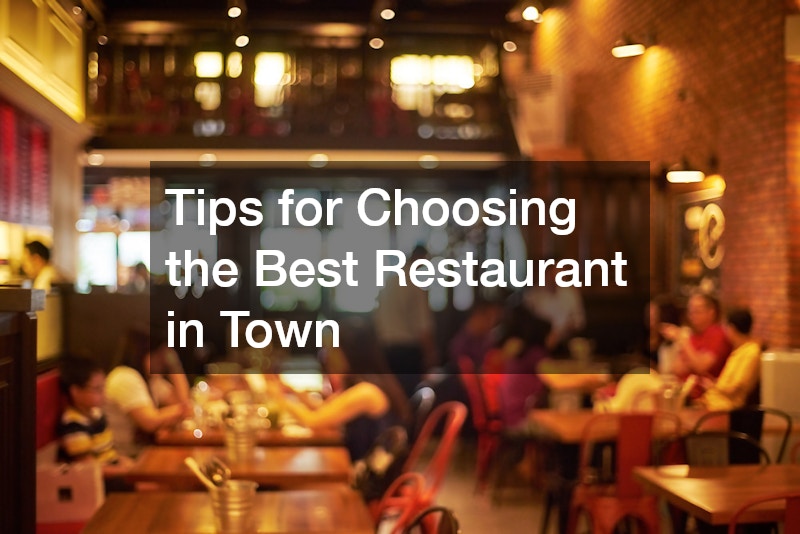Choosing a restaurant can be both exciting and overwhelming. With countless options available, from casual eateries to fine dining establishments, deciding where to go requires more than just a quick glance at a menu or a passing recommendation. Whether you are planning a special night out, a casual meal with friends, or a family dinner, knowing how to identify the right restaurant for your needs is essential. This guide provides practical tips to help you make a confident choice and ensure a memorable dining experience.
Consider the Type of Cuisine
The first step in finding the ideal restaurant is determining the type of cuisine you want to enjoy. Are you in the mood for Italian, Japanese, Mexican, or perhaps something more exotic? Understanding your culinary preference will narrow your options and make your search more efficient.
In addition to your own preferences, consider the preferences of your dining companions. A restaurant that offers a diverse menu can accommodate everyone, from vegetarians and vegans to meat lovers. Many online platforms provide detailed menus and even photographs of dishes, which can help you get a sense of the restaurant’s offerings before you make a reservation.
It’s also important to think about the authenticity and quality of the cuisine. Reading customer reviews and checking for expert ratings can give insight into whether a restaurant genuinely excels at the type of food it serves. The goal is not just to find a meal that satisfies hunger but to enjoy a culinary experience that feels authentic and carefully crafted.
Evaluate the Ambiance and Atmosphere
While food quality is critical, the overall atmosphere of a restaurant plays a significant role in your dining experience. Ambiance encompasses lighting, music, decor, seating arrangements, and even the general vibe of the place. A restaurant with a relaxed, cozy atmosphere may be perfect for a casual evening, while a lively, vibrant environment could be ideal for social gatherings.
Consider your purpose for dining. If you are planning a romantic date, a restaurant with intimate lighting and comfortable seating might be more suitable. On the other hand, for a business lunch, you may prefer a quieter space that allows for conversation without distraction. Observing photos online or reading descriptive reviews can help you gauge the ambiance before visiting.
Another key factor is the cleanliness and organization of the establishment. A tidy, well-maintained restaurant not only makes the experience more pleasant but also reflects the management’s attention to detail and commitment to customer satisfaction. Staff professionalism and friendliness also contribute to the overall atmosphere, enhancing your comfort and enjoyment.
Assess the Service Quality
Service quality can make or break a dining experience, regardless of how good the food is. Attentive, knowledgeable, and courteous staff create a welcoming environment and help ensure that your meal proceeds smoothly.
When choosing a restaurant, look for indicators of consistent and reliable service. Online reviews often highlight both positive and negative experiences with staff. While a single negative review may not be indicative of overall quality, recurring patterns in multiple reviews can signal potential issues.
Timeliness is another aspect of good service. Efficient service ensures that your food arrives at the right temperature, your drinks are refilled, and any special requests are handled appropriately. In addition, a restaurant that accommodates dietary restrictions or customization requests demonstrates flexibility and a customer-focused approach. Excellent service elevates a dining experience from ordinary to memorable, making it an important consideration when selecting the best restaurant for your needs.
Check Location and Accessibility
Practical considerations such as location and accessibility should not be overlooked. A conveniently located restaurant reduces travel stress and allows you to enjoy your outing without logistical concerns. Proximity to parking, public transportation, and pedestrian-friendly areas can make a significant difference in overall convenience.
Accessibility also includes considerations for individuals with mobility challenges. Restaurants that provide ramps, spacious seating, and accessible restrooms ensure that everyone can enjoy the experience comfortably. Additionally, checking operating hours and peak times helps you avoid long waits or overcrowded conditions.
In some cases, online reservations can be a helpful tool, particularly for popular restaurants that experience high demand. Booking ahead guarantees your spot and allows you to plan your visit with confidence. Combining convenience with thoughtful planning ensures that the dining experience is smooth and enjoyable from start to finish.
Selecting the right restaurant involves more than just choosing a place to eat; it’s about creating an experience that satisfies both your taste buds and your expectations. By considering factors such as cuisine, ambiance, service quality, and location, you can make an informed decision and enjoy a memorable outing.
Whether you are seeking a casual meal with friends or a special evening out, these tips provide a framework to guide your choice. Taking the time to research and plan can transform an ordinary dinner into a delightful experience. With careful consideration and attention to detail, you can confidently find the best restaurant in town that meets your culinary preferences and ensures a positive dining experience every time.


